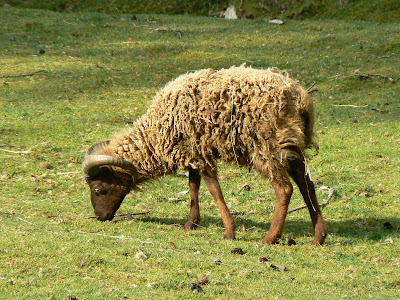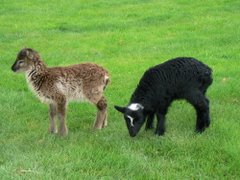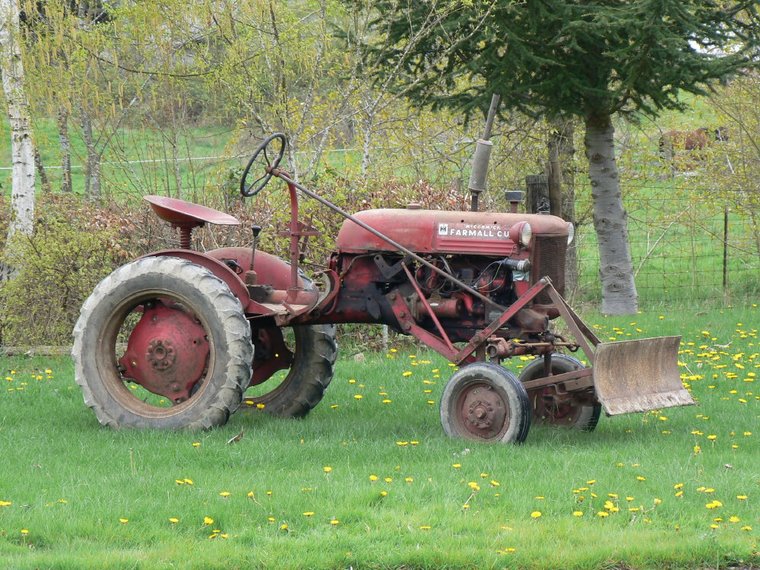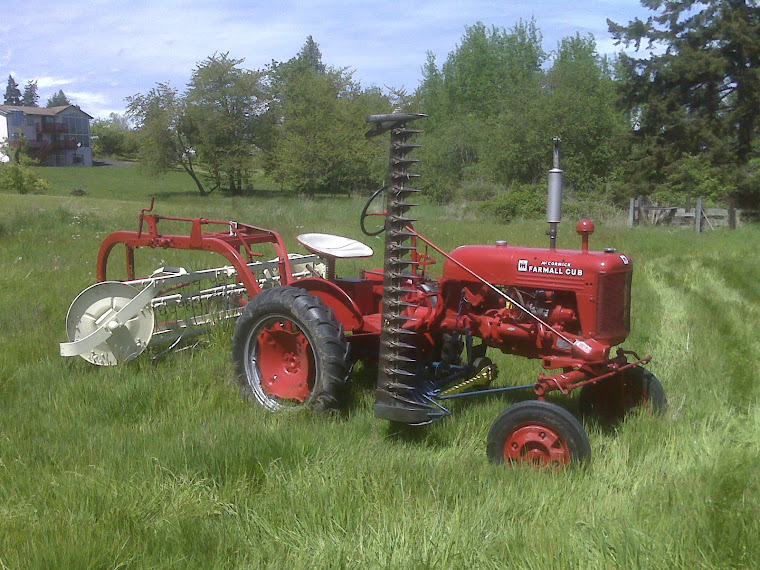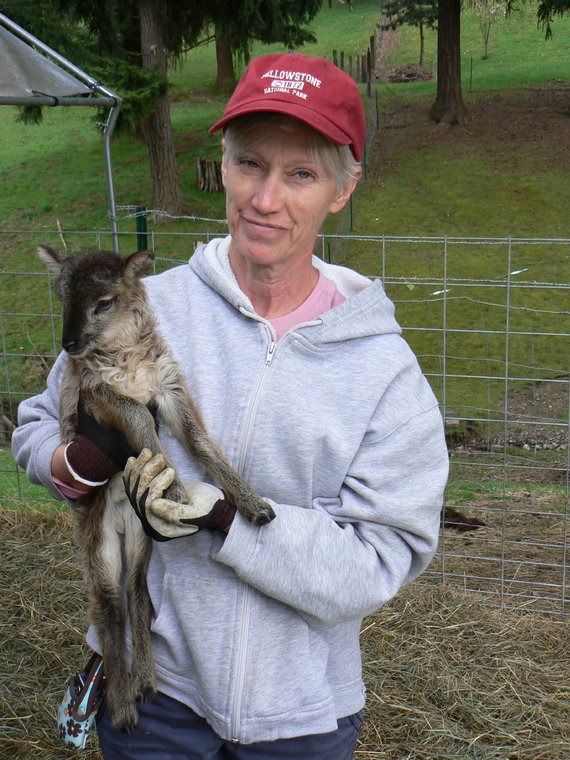Tuesday, May 18, 2010
Lambing for final light-wild Skylonda Soay ewe at Woodland Creek
Friday, May 7, 2010
Two new lambs and a stroke of luck
I would have never thought of this (never did, obviously) as a risk. Since I don't count heads every day, and had to work the next couple days, it is likely the lamb would have expired had I not, by chance, decided to go up and visit.
Naturally, the one trunk of the hawthorne was removed to eliminate the hazard. The ewes enjoyed getting their revenge on the "almost killer" hawthorne.
Sunday, April 11, 2010
Ten to Fourteen...
The real excitement, however, was saved for Saturday. Not only did I obtain my first RBST Soay from Jen Bailey at Skylonda when she dispersed her flock, but she also graced me with many light phase Soays. So the only light-phase RBST Soay that we have at Woodland Creek, USA0002 Fiona, rather suddenly swelled up and decided to lamb.
For my viewing pleasure, she did it mid-day on a Saturday, so I got to observe (and videotape!) the entire birth.
The best part is that she gave birth to twins. Not that uncommon with Soay, but pretty rare at Woodland Creek! We have only had one successful twin live birth here in 5 years and about 65 lambings.
Given that Fiona was light phase, and the sire Blue Mountain Express was also homozygous for recessive light phase, the lambs HAD to be light phase. Since there is no evidence of self-colored in the "legacy" RBST Soay in NA, the lambs had to be wild pattern. Sure enough, they were.
Wednesday, April 7, 2010
Number 9, number 9, number 9...
Tuesday, April 6, 2010
Lambing update - Self-colored Light phase
Of course the odds are not that good. Below is a table showing the possibilities for mating two "half-SCLP" Soays.
Friday, March 26, 2010
Lamb status at Woodland Creek
Lambing count stands at 5 (live) and more on the way within days, I would say.
Thursday, March 25, 2010
And now for something completely different
Mystery solved - missing lamb found
(Spoiler alert - if you don't like photos of dead lambs, you should stop reading now and go find something more pleasant).
So, genetically, the lamb was of course a black-and-white, as the sire was Yosemite (same sire as Athena's lamb yesterday) and Thumper was our original B&W ewe. Since Athena was Thumper's daughter, the dead ram lamb was Athena's lambs "half-brother" as well as "half-uncle". The interesting part is the ram lamb's markings, shown below.
Wednesday, March 24, 2010
Soay sheep lamb weights and owl lift capabilities
Predictors of early survival in Soay sheep: cohort-, maternal- and individual-level variation
Owen R Jones,* Michael J Crawley, Jill G Pilkington, and Josephine M Pemberton, Proc Biol Sci. 2005 December 22; 272(1581): 2619–2625. Copyright © 2005 The Royal Society
http://www.ncbi.nlm.nih.gov/pmc/articles/PMC1559978/
Their data set was the 1989 to 2002 surveys of Soay sheep on the island of Hirta in the St. Kildas, so it is "real" Soay sheep.
While not explicitly publishing lamb weights, they reported them in their analysis on survival factors. From their Figure 2a, shown here:
I extracted their data from the figure above and calculated a mean value for weights in pounds.
A much better lambing result today
Tuesday, March 23, 2010
Rare Soay sheep photo
Note that the second and third both also have white spotting - another breeding goal I have is to add extensive white spotting to these more rare genotypes.
And to Soay purists, I will acknowledge that the two with white spotting are not the best conformation ever seen. That's a problem with rare genotypes--one tends to keep them all to retain the genetics even if the conformations are not great. But succeeding generations should be able to recover the conformation.
Where oh where has my little lamb gone?
Tuesday, March 16, 2010
First 2010 Soay sheep lamb at Woodland Creek

More on the way!
Saturday, March 6, 2010
Lambing Time - Breeding Groups
Ever since obtaining my first Soay sheep I have been far more interested in the coat color genetics and the rare (because they are recessive genes) patterns. Consider the occurrance of frequencies of the discreet observable (phenotypic) coat patterns expressed in Soay sheep due to the 3 disinct coat color genes: Agouti (Wild or self pattern), Brown (dark or light phase), and Spotting (white spots or none).
(If you really want to read more about this, you can in this article I have posted: http://woodlandcreekfarm.com/coat_patterns.pdf )
With 3 independent coat color gene loci, and with only 2 mutually exclusive types at each of these, there are (2*2*2)= 8 possible phenotypes one can observe. To give the reader some idea of the relative numbers of these that likely exist in a Soay Sheep population unaltered by human selection, I have extracted various numbers from published studies of Soay on the island of Hirta and combined them to show typical likely relative frequencies. I intend to report these more fully in a technical article, but for now I will post the data here. (Click on image to enlarge it enough to read it).
 Note that by total count, for the most rare genotype (triple homozygous recessive - Aa/Aa, Bb/Bb, Ss/Ss, aka white-spotted light-self), there was only one such Soay found out of 1,835 total Soay counted on all of Hirta in 1966. Pretty darn rare. Even the pattern with only two of the recessive genes - self and white spotting, (that is, self-colored blacks with white spotting) showed only 4 individuals present in that same survey of 1,835 animals. The remainder of this blog will discuss our progress on that "line" of breeding.
Note that by total count, for the most rare genotype (triple homozygous recessive - Aa/Aa, Bb/Bb, Ss/Ss, aka white-spotted light-self), there was only one such Soay found out of 1,835 total Soay counted on all of Hirta in 1966. Pretty darn rare. Even the pattern with only two of the recessive genes - self and white spotting, (that is, self-colored blacks with white spotting) showed only 4 individuals present in that same survey of 1,835 animals. The remainder of this blog will discuss our progress on that "line" of breeding.
So my first "relatively rare" genotype was to get some self-colored black Soays. When I realized that some also showed white spotting on their heads, I began to seek increasing the extent of white spotting on the self-colored blacks, as this gave a very pleasing appearance. So this has been one of my longer-running breeding groups - the "black and whites" (B&W).
These will give you some idea of the progress I've made in 5 years. The first B&W ram I had only had a small white wisp on the top of his head.
He sired a ram lamb (Woodland Creek Pepper) when mated with a similarly marked ewe, with a nice white spot on his head, and a second (Woodland Creek Obsidian) with both a white head spot and forehead spot.
Chilcoot, mated with a B&W ewe, produced a ram lamb Woodland Creek Yosemite, that had a white head spot connected with a full white facial blaze. The white additionally extended to some white spots on the side of his neck.
Chilcoot also sired that year a B&W ewe lamb with additional white spotting extent, Woodland Creek Athena.
Woodland Creek Athena '09
In the next year, with a different B&W ewe, Chilcoot produced a B&W ram lamb (Woodland Creek Lakotah) with even more extensive white.
You can see how the extent of white spotting has been increased in each succeeding generation, going from a small white head spot, to a larger head spot, to a head and forehead spot, to a "shield" connecting the head and forehead spot, to a blaze, to a blaze with neck spots, to (with Lakotah above) now a full blaze nearly encircling the horns, including his nose, a full "necklace" and a white bib, and even some white on his ears.
So back to the B&W breeding group and this year's hopes for lambs. Lakotah was too immature to use for breeding last fall, so Yosemite was the sire for our B&W ewe group. We have seven B&W ewes in that group (although a couple are yearling ewes that may not have been mature enough to be bred).
You may be able to imagine the anticipation I have at what unexpected outcome we may get this year for our B&W lambs! Judging by swelling udders this could occur within days.
More about our other breeding groups in later blogs.
Saturday, February 13, 2010
Separation of church and state
So as of today, Woodland Creek Farm Soay sheep blog will only (mostly) deal with Soay sheep, and we will start a separate Raven's Call Vineyard and Winery blog.
So back to the main topic here - Soay Sheep.
We've had some major changes in our breeding program here - mostly prompted by un-planned acquisition of the majority of the self-colored light phase NA Soay sheep in North America....(OK - so there are 2 for sure, and maybe one more - status unknown).
And sure, you have to be a real sheep coat color genetics geek to have any interest at all in this... but here they are:











